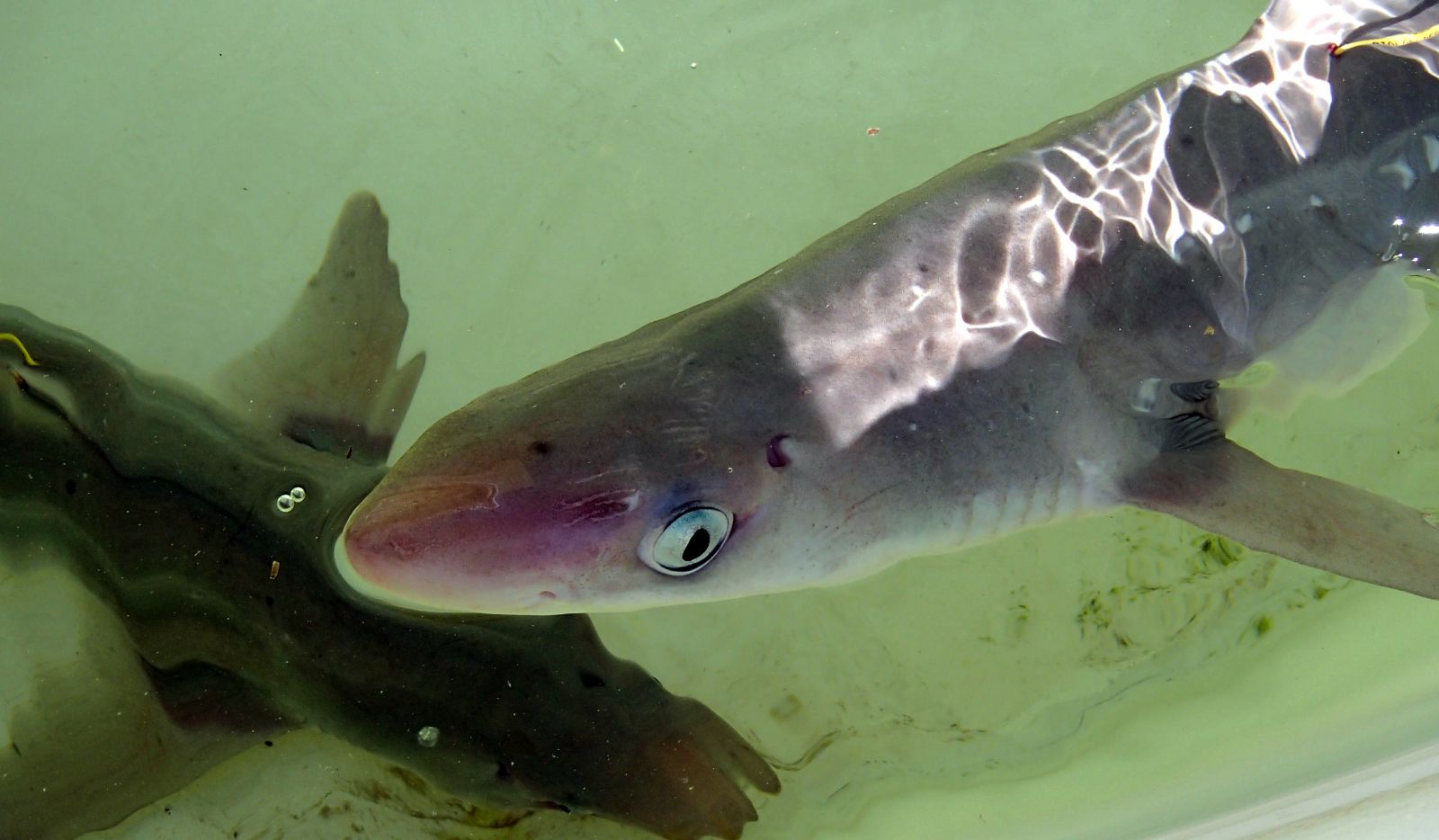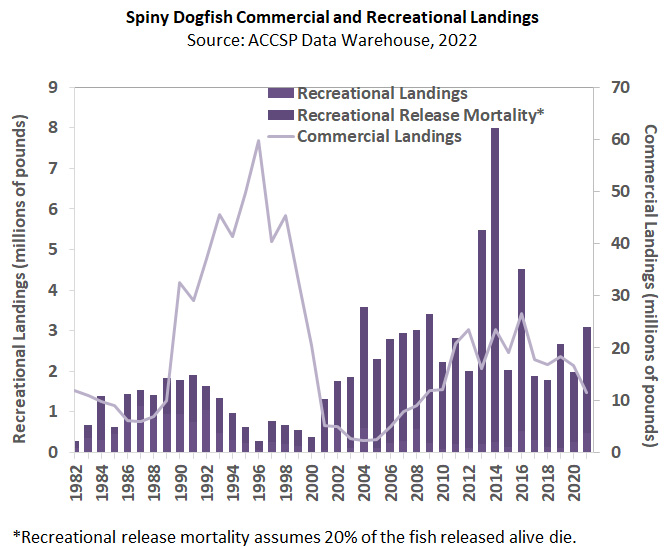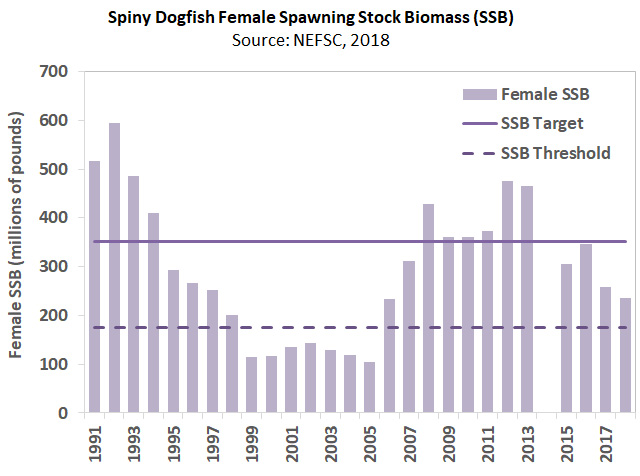Spiny Dogfish
Life History

Spiny dogfish captured as off of Morehead City, NC as part of a feeding study. Photo credit: Chuck Bangley, East Carolina University.
Spiny dogfish (Squalus acanthias) are a small shark species that inhabit both sides of the North Atlantic and North Pacific Oceans, mostly in the temperate and subarctic areas. In the Northwest Atlantic, the stock ranges from Labrador to Florida, and is most abundant from Nova Scotia to Cape Hatteras. Spiny dogfish migrate north in the spring and summer and south in the fall and winter. In the winter and spring, they congregate primarily in Mid-Atlantic waters but also extend onto the shelf break of southern Georges Bank. In the summer, they are located farther north in Canadian waters and move inshore into bays and estuaries. By autumn, dogfish have migrated north with high concentrations in Southern New England, on Georges Bank, and in the Gulf of Maine. They remain in northern waters throughout autumn until water temperatures begin to cool and then return to the Mid-Atlantic.
Juvenile spiny dogfish school by size until sexually mature and then aggregate by both size and sex. Female dogfish reach sexual maturity at 12 years (~29.5 inches), while males reach sexual maturity at six years (~23.6 inches). Mating occurs in the winter months and the pups are delivered on the offshore wintering grounds. Females give birth every two years with litters ranging from two to 15 pups. While carrying one litter, the female will begin developing eggs for the fertilization of her next litter. After an 18 to 24 month gestation period, pups are released live and fully formed at about 14 inches.
Commercial & Recreational Fisheries

Prior to the Fishery Conservation and Management Act of 1976 (now known as the Magnuson-Stevens Reauthorization Act), foreign fleets caught the majority of dogfish in U.S. waters but U.S. fishermen have had uncontested access ever since the Act's passage. The National Marine Fisheries Service (NMFS) encouraged commercial fishermen to target the bountiful stocks of spiny dogfish in the 1980s and 1990s when stocks of other commercially valuable fish in the Northeast declined. Then in 1998, NMFS determined that spiny dogfish were overfished and implemented stringent harvest restrictions in federal waters to allow the stock to rebound. The states followed shortly after with complementary regulations for state waters. Today, commercial fishermen catch spiny dogfish using longlines, trawls, and purse seines. Fishermen target female dogfish because the females grow larger than males and tend to school together. Processors prefer the larger dogfish because they are easier to hold and cut. The commercial fishery supplies the European food fish markets that use dogfish "belly flaps" for fish and chips in England and as a popular beer garden snack called shillerlocken in Germany.
There is also a small scientific fishery in Maine, which uses spiny dogfish to study several of the species' unique biological characteristics. Dogfish have an organ called a rectal gland whose study helps scientists better understand the function of human kidneys. They also secrete a molecule called squalamine, which has strong antibiotic characteristics and shows promise as an anticancer agent.
Landings were approximately 37.2 million pounds in 1992, gradually increasing to a peak of about 60 million pounds in 1996. In the late 1990s, landings declined to an average of around 40 million. After federal and state regulations were implemented in the early 2000s, landings declined to less than five million pounds in 2001 and 2002. They then ranged between two and eight million pounds between 2003 and 2009. As the stock began to improve, landings were increased to 21 million pounds in 2011. Commercial landings continue to be mostly female dogfish, with female landings comprising about 98% of the total commercial catch.
In the 2022/2023 fishing year, commercial landings were estimated at 12.6 million pounds, while recreational harvest was estimated at 211,608 pounds. Discards have remained fairly stable, around 11 million pounds over the past decade and are expected to remain near that level in the future. Canadian and foreign landings have also decreased significantly in recent years. It is anticipated the Canadian dogfish harvest will not increase in the near future given the lack of demand for the product and the subsequent closure of Canadian spiny dogfish processors.
Stock Status

The 2023 Management Track Stock Assessment indicates that spiny dogfish are not overfished and overfishing is not occurring. The spawning stock biomass estimate of 191 million pups is slightly above the SSB threshold of 188 million pounds, while the fishing mortality estimate (0.02) is just below the fishing mortality threshold (0.0246). However, the assessment also found a lower productivity of the stock, requiring reduced quotas to prevent overfishing in the future.
Atlantic Coastal Management
In 1998, NMFS declared spiny dogfish overfished and initiated the development of a joint fishery management plan (FMP) between MAFMC and the New England Fishery Management Council (NEFMC) in 1999. The Commission approved an Interstate FMP to complement the federal plan in 2003. Both the Commission and federal plans use a fishing mortality rate to set annual quotas and trip limits. The Commission's FMP has an additional five addenda (Addenda I - V).
The spiny dogfish fishery, which operates from May 1 through April 30, is managed though an annual commercial quota, which is further allocated by state shares. Maine through Connecticut receive 58% of the quota and are limited by a maximum possession limit of 6,000 pounds per day. The southern state shares are allocated as follows: New York (2.7%); New Jersey (7.6%); Delaware (0.9%); Maryland (5.9%); Virginia (10.8%); and North Carolina (14.0%). Any overages from the previous fishing seasons are paid back by the region or state in the following season.
In October 2019, the Board approved Addendum VI to the FMP, which allows commercial quota to be transferred between all regions and states to enable the full utilization of the coastwide commercial quota and avoid quota payback for unintended quota overages. Previously, the FMP only allowed quota transfers between states with individual allocations, with regions excluded from benefitting from quota transfers. Moving forward, in order for states within a region to participate in quota transfers, the Director of each state’s marine fisheries agency within the region must agree to the transfer in writing. As with transfers between states, transfers involving regions do not permanently affect the shares of the coastwide quota. Additionally, the Addendum extends the timeframe for when quota transfers can occur up to 45 days after the end of the fishing year to allow for late reporting of landings data.
In January 2024, based on the results of the 2023 management track assessment, the Board approved the following coastwide commercial quotas for the 2024-2026 fishing years: 10,699,021 pounds for 2024/2025; 10,972,394 pounds for 2025/2026, and 11,223,720 pounds for 2026/2027. These quotas are consistent with the measures recommended to NOAA Fisheries by the Mid-Atlantic Fishery Management Council and are pending approval of identical federal quotas from the NOAA Fisheries Greater Atlantic Regional Fisheries Administrator. Additionally, the Board maintained a 7,500-pound trip limit for the northern region.
Meeting Summaries & Reports
Board Proceedings
- 2023 Oct Aug Feb
- 2022 Jan
- 2021 Oct
- 2020 Oct
- 2019 Oct Aug
- 2018 Oct
- 2017 Oct
- 2016 Oct Feb
- 2015 Nov
- 2014 Oct Aug May
- 2013 Oct May Feb
- 2012 Oct Aug May
- 2011 Aug Mar
- 2010 Nov Aug May Feb
- 2009 Nov Aug May Feb
- 2008 Oct Aug May
- 2007 Oct Aug May Jan
- 2006 Oct Aug Feb
- 2005 Nov Aug
- 2004 Nov
- 2003 Dec Jun Feb
- 2002 Nov Aug May
- 2001 Oct Jul Apr Jan
- 2000 Oct Aug Feb
- 1999 Aug
Press Releases
- ASMFC Spiny Dogfish Board Sets Quota for 2023/2024 Fishing Season (February 2023)
- ASMFC Spiny Dogfish Board Sets Quotas for 2021-2023 Fishing Seasons (October 2020)
- ASMFC Spiny Dogfish Board Approves Addendum VI (October 2019)
- ASMFC Spiny Dogfish Board Approves Draft Addendum VI for Public Comment (August 2019)
- ASMFC Spiny Dogfish Board Sets Quotas for 2019-2021 Fishing Seasons (October 2018)
- ASMFC Spiny Dogfish Board Approves 2018 Fishery Specifications (October 2017)
- ASMFC Spiny Dogfish Board Approves 2017 Fishery Specifications (October 2016)
- ASMFC Spiny Dogfish Board Approves 2016/2017 Specifications (February 2016)
- ASMFC Spiny Dogfish Board Approves Addendum V to Ensure Consistency with the Shark Conservation Act (October 2014)
- ASMFC Spiny Dogfish Board Releases Draft Addendum V for Public Comment: Massachusetts Schedules Public Hearings (August 2014)
- ASMFC Spiny Dogfish Board Approves Draft Addendum V for Public Comment (August 2014)
- ASMFC Spiny Dogfish Board Initiates Draft Addendum V to the Spiny Dogfish Interstate Fishery Management Plan (May 2014)
- ASMFC Spiny Dogfish Board Revises Quotas for 2014/2015 and 2015/2016 Fishing Seasons (November 2013)
- ASMFC Spiny Dogfish & Coastal Sharks Board Approves Smoothhound Shark Addendum II & Initiates Draft Addendum III (May 2013)
- ASMFC Approves Smooth Dogfish Draft Addendum for Public Comment (February 2013)
- ASMFC Spiny Dogfish Board Sets Quotas for 2013-2015 (October 2012)
- ASMFC Spiny Dogfish Board Increases 2012/2103 Quota to 35.6 Million Pounds and Approves Draft Addendum IV for Public Comment (May 2012)
- ASMFC Sets Spiny Dogfish 2012/2013 Fishing Year Quota at 30 Million Pounds (November 2011)
- ASMFC Spiny Dogfish & Coastal Sharks Board Approves Addendum III: State-Specific Spiny Dogfish Shares Established for Southern Region (March 2011)
- ASMFC Sets Spiny Dogfish 2011/2012 Fishing Year Quota at 20 Million Pounds (November 2010)
- ASMFC Sets Spiny Dogfish 2010/2011 Fishing Year Quota at 15 Million Pounds (February 2010)
- ASMFC Spiny Dogfish & Coastal Shark Board Approves Addendum I to the Interstate Shark FMP (August 2009)
- ASMFC Spiny Dogfish Board Approves Initiation of Smooth Dogfish Addendum (February 2009)
- ASMFC Spiny Dogfish Board Approves Addendum II (October 2008)
- ASMFC Spiny Dogfish Board Sets 2009/2010 Fishing Year Quota at 12 Million Pounds (October 2008)
- ASMFC Approves Interstate Fishery Management Plan for Atlantic Coastal Sharks (August 2008)
- ASMFC Spiny Dogfish Board Initiates Two Addenda to Address Quota Allocation (May 2008)
- ASMFC Releases Draft Interstate Fishery Management Plan for Atlantic Coastal Sharks for Public Comment (January 2008)
- ASMFC Spiny Dogfish Board Sets 2008/2009 Fishing Year Quota at 8 Million Pounds (October 2007)
- ASMFC Spiny Dogfish Board Revises 2006/2007 Quota and Sets Specifications for 2007/2008 Fishing Year (October 2006)
- ASMFC Spiny Dogfish Board Approves 4 Million Pound Quota for the 2006/2007 Fishing Year (November 2005)
- ASMFC Spiny Dogfish Board Approves 4 Million Pound Quota for 2005 - 2006 Fishing Year (November 2004)